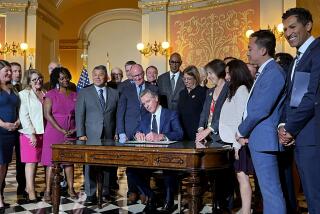
- Share via
With Californians angry about their skyrocketing electric bills, Gov. Gavin Newsom issued an executive order on Wednesday aimed at giving them some relief.
The governor’s order directs the state Public Utilities and Energy commissions to find ways to try to lower power bills in the future, or at the minimum to stop them from rising so quickly.
Among the actions he asks for is a closer review of how utilities are spending money to stop transmission lines from sparking wildfires. State officials say those wildfire mitigation costs now make up about 13% of customers’ monthly electric bills.
“We’re taking action to address rising electricity costs and save consumers money on their bills,” Newsom said. “California is proving that we can address affordability concerns as we continue our world-leading efforts to combat the climate crisis.”
The governor issued the executive order days before Tuesday’s election, in which kitchen-table economics is a top concern.
California now has the second-highest electric rates in the country after Hawaii. Residential customer bills have risen by as much as 110% in the last decade.
In just the past three years, bills for customers of the three biggest for-profit utilities — Pacific Gas & Electric, Southern California Edison and San Diego Gas & Electric — have increased by 20% to 50%. Those most recent rate increases were reviewed and approved by Newsom appointees at the state public utilities commission.
The executive order is just one of Newsom’s recent moves aimed at reducing soaring energy costs. In August, he and Democratic lawmakers released a suite of energy-related bills just days before the legislative session ended. That same month the governor ordered lawmakers to return to Sacramento for a special session to debate a bill that would require oil refineries to increase gasoline reserves in an attempt to prevent price spikes at the pump.
The governor’s staff say Newsom is committed to the state’s ambitious climate goals, which include having 100% clean electricity by 2045. But he has become concerned as electric rates have risen to cover the cost of the state’s fast construction of solar farms and other renewable power, they say.
Newsom’s executive order asks his administration to look for “underperforming or underutilized programs” that are paid for by electric customers that could be ended. It says any unused money in those programs should be returned to customers.
In addition, the order asks the state’s Air Resources Board to determine how the California Climate Credit could be increased. Most Californians’ get the credit twice a year on their electric and gas bills. The credit is funded by the state’s cap-and-trade program, which attempts to reduce harmful emissions.
The order also directs the state Public Utilities Commission to pursue all federal funding opportunities that could reduce electric costs.
An early plan by Newsom’s office for the executive order that was reviewed by The Times asked the public utilities commission to look into alternative ways of financing the building of electrical lines and other infrastructure. Currently, building infrastructure is a key way for utilities to boost their profits because they bill the cost back to ratepayers over many years, tacking on annual interest that is typically 10.5%.
Consumer groups say that lowering this rate could result in significant savings for customers.
The governor’s executive order released Wednesday didn’t include that provision. His staff said the directive to find other ways of financing infrastructure wasn’t included in the executive order because it would require legislative statutes to be changed.
In August, Newsom backed away from an earlier plan he had to lower the infrastructure interest rate after criticism from the big utilities and electrical workers’ union, according to a report by the Sacramento Bee.
Reactions to the governor’s executive order were mixed.
“We know Californians are struggling with high costs of living, we share Gov. Newsom’s commitment to helping keep electricity costs down and look forward to working with him on this effort,” said David Eisenhauer, a spokesman for Southern California Edison.
CALPIRG, a consumer group, said it was concerned that the executive order could lead to cuts in clean energy programs that the group believes are crucial.
“The real drivers of high utility bills are wasteful utility spending and excessive profits,” said Jenn Engstrom, CALPIRG’s state director. “Unfortunately the governor’s executive order does little to hold utilities accountable for wasting ratepayers’ money. Ensuring utilities don’t overspend on wildfire mitigation is a good step, but way more needs to be done to rein in these companies’ profligate ways.”







